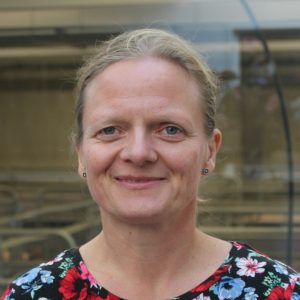Tips and tricks to ensure good welfare for both sows and piglets
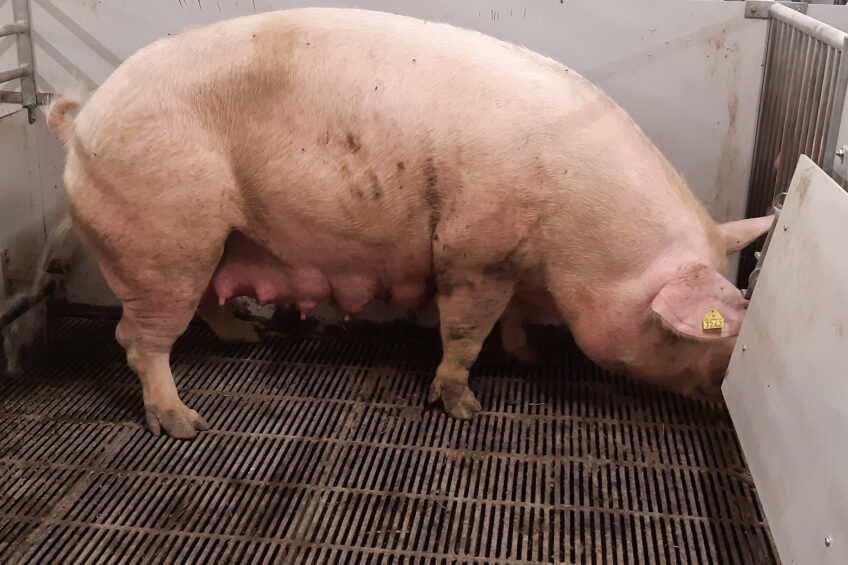
Whether producing pigs in a traditional farrowing crate or a loose farrowing and lactation system, it is always vital to take a fresh look at where improvements can be made. The farrowing environment must cater to the diverse needs of sows, piglets and producers. Failure to meet these needs results in reduced performance and animal welfare issues.
What does an ideal farrowing pen look like? To answer that question, meeting the physical space requirements of the animals is key, to ensure both sows and their litters can easily manoeuvre to feed and drink. This article discusses 3 options. Firstly, some general comments to consider – then there are considerations depending on each type of system (crates or loose).
 General consideration for all sows
General consideration for all sows
Space considerations for large litters
EU legislation requires there is sufficient space for all piglets in a litter to rest at the same time on a solid floor. The number of piglets in the litter and the size they will be at weaning determines how much space is needed to meet this legislative requirement. Alternatively, the available space determines the number of piglets the pen can accommodate. To avoid crushing, the lying area for piglets must be well separated from the lying area of the sow.
Across genetic lines, litter size has increased leading to management strategies to either fully utilise the sows’ nursing capacity, increase the use of nurse sows or use supplementary milk within the home-pen, to accommodate a greater number of piglets within one farrowing pen.
For nurse sows, pen design criteria should follow a standard pen design. If the number of piglets in the pen outnumbers the number of functional teats by more than 1 to 2 piglets, it is essential to provide supplementary milk for the piglets. It is important to place the supplementary milk where piglets can easily locate it, but are also motivated to use it.
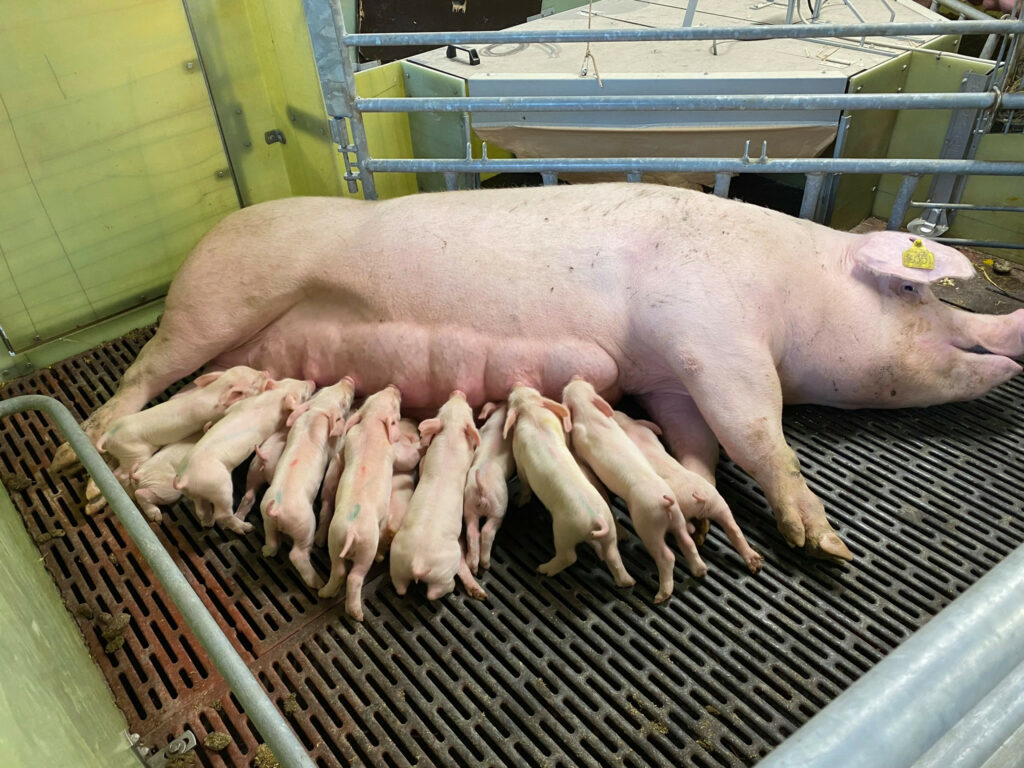
Nest-building material
The development of loose farrowing pens has been influenced by more attention for the increased activity of the sows prior to farrowing. They do so as they are stimulated to build a nest by hormonal changes, hence there are concerns over restrictions of sows during those important phases of life.
Therefore, provision of nesting material is necessary to satisfy the sows’ motivation to building a nest. Increased oxytocin levels are observed at sows feeling satisfied with having built a nest, resulting in improved maternal behaviour post-farrowing, which again translates into carefulness and attentiveness to piglets. Sows that can display a greater nest building activity and appear to build a “satisfactory” nest – suggesting the motivation to nest build has been met satisfactorily – have reduced piglet mortality.
There is a large variability in the quantity of nest building material that sows use. It is most important is to make sure nest building material is available so the sows can choose their use of it, rather than providing a set quantity. Providing sows with a sterilised burlap strip (165 cm x 60 cm) in the days prior to farrowing reduced stillbirths (burlap: 6.5% vs control: 8.3%).
Specific piglet requirements
Although housed in the same room, sows and piglets have very different microclimate needs. Failure to keep the sows in their thermoneutral zone (18-22ºC) will result in lower milk output and will increase sow water intake. If the water supply is insufficient, the milk production will decrease impacting the weight gain of the piglets.
Piglets require a higher microclimate between 30-34°C from birth to weaning. Piglets are most susceptible to hypothermia in the immediate post-partum period, but deviations in the thermoneutral zone will influence piglet productivity throughout lactation. Improvements in piglet survival are achieved through the targeted provision of heat in the areas where piglets spend time in the hours following birth. In farrowing crates, supplemental heating at the rear of the sow (birth area) and adjacent to the sow’s udder can reduce mortality. Heat mats are proven to reduce the heat loss experienced by piglets in the first 30 minutes after birth by up to 1.5°C compared to lying on a slatted floor.
Piglets also need space for healthy behaviour development. The space litters of piglets have available in the farrowing environment has been found to alter social behaviour development. Litters of piglets reared in smaller pens (3.5 m2 for 7 to 8 piglets) demonstrate more aggressive social behaviour than piglets reared with more space (6.7 m2). With an increase in litter sizes and a push to rear more piglets per litter, consideration for expanding the total area of the farrowing pen for crated sows is valuable, to ensure sufficient room for the piglets to nurse, feed and rest comfortably, but to also support healthy behaviour development.
 When keeping sows in a crate
When keeping sows in a crate
Spatial dimensions
At its most basic level, the spatial dimensions in a crate and pen must accommodate the dimensions of the sows and piglets, with consideration for their growth with parity and pre-weaning growth.
When sows get up and lie down, they use about 50 cm beyond the length of their body and about 40 cm beyond the width of their body. A crate that is too narrow will result in sows adjusting their postural behaviours to accommodate to the reduced space. In addition, a narrow crate affects the sows’ opportunity to rest, influencing lactation postures and can result in a higher incidence of skin lesions and bruises from contact pressure on the bars of the crate.
Research shows that both sows and piglets benefit from having more space available during lactation. Housing sows in wider farrowing crates (23 cm wider at the front, 30 cm wider at the rear) improves teat access for the piglets, resulting in improved weight gain of piglets pre-weaning, fewer teat fights, fewer piglets missing out on milk-let down and fewer terminations of suckling by the sow.
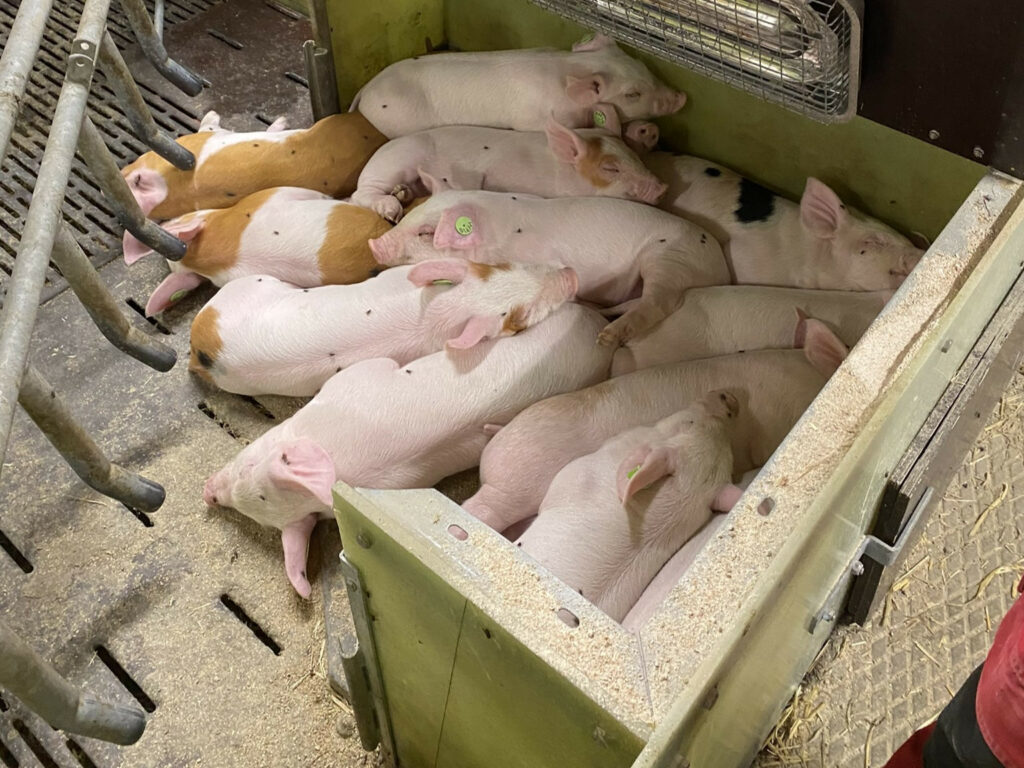
 When opting for loose sows at farrowing
When opting for loose sows at farrowing
An upcoming way of looking to housing sows during farrowing is to keep the animals loose during (most of) the farrowing phase. Ther are various reasons to opt for that, for instance the fact that housing sows loose during lactation results in a 25% increase in the duration of milk letdown than sows housed in crates.
In that case the farrowing environment must also provide space for the pigs to carry out essential behaviours: standing up and lying down, turning, nest building, nursing, exploring, bonding, resting, eating and defecating.
Separate areas for behaviours
Sows and piglets are motivated to have separate areas for specific functional behaviours: resting, eating and dunging. When sows are loose housed, awareness and acknowledgement of their behavioural preferences becomes of upmost importance and the design and placement of pen features impacts the success of the pen design.
To facilitate safe working conditions and reduce the risk for spread of disease between pens, it is recommended to place the creep area alongside the aisle where stock people walk, enabling daily checks without entering pens. Considering the sows’ need to rest close to the piglets, the sows’ lying area should be placed adjacent to the aisle leaving the dunging area to be placed away from the aisle.
A minimum width for sows to turn around in loose farrowing pens has been proposed as 153 cm. Awareness of the minimum dimensions required by the sow are important to consider; individual European countries such as Austria and Germany are setting their own regulatory standards for pens for loose farrowing sows, with Germany requiring pens to have a circular area with a diameter of at least 200 cm for the sow to turn around.
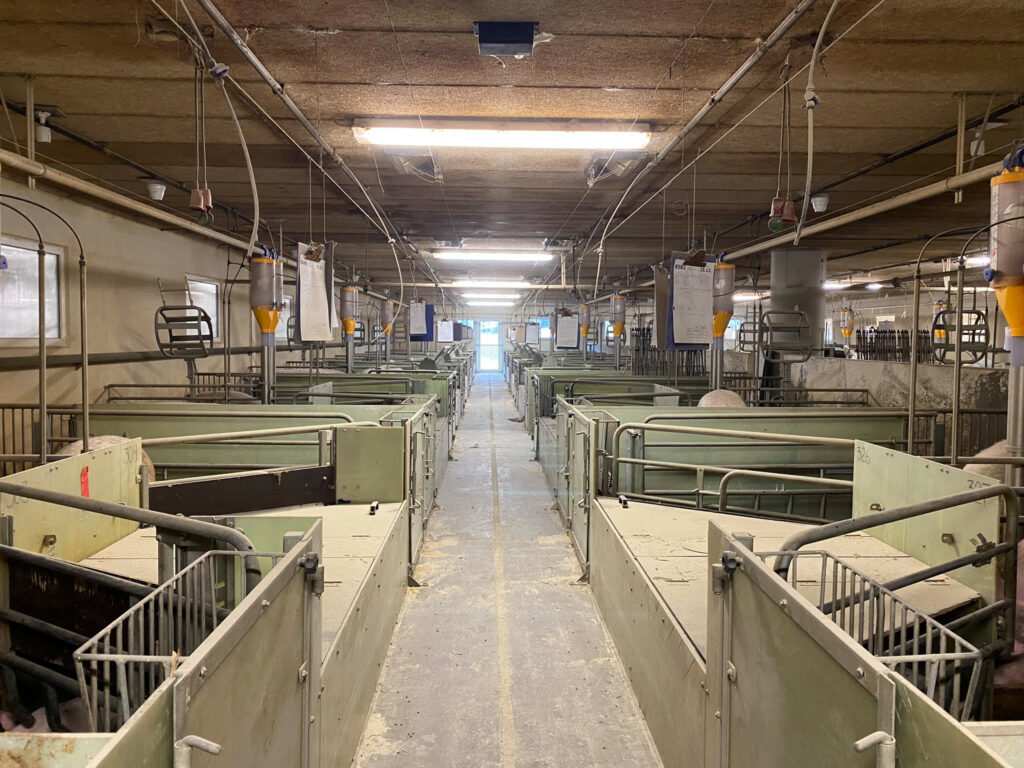
Zero or temporary confinement
The design of loose sow pens is critically important to reduce the risk of piglet mortality. If the sows are confined, the sows and piglets do not share a common space when resting, reducing crushing risk. When sows are loose at farrowing or shortly thereafter, the risk of piglet mortality from crushing is higher.
That is in large part due to space sharing between sow and piglets, and a reduction in the availability of support for the sow when lying down. For sows that are loose during farrowing, critical to reduce piglet mortality are the size of the nest area and the placement of a sloped wall to support the sow when lying down.
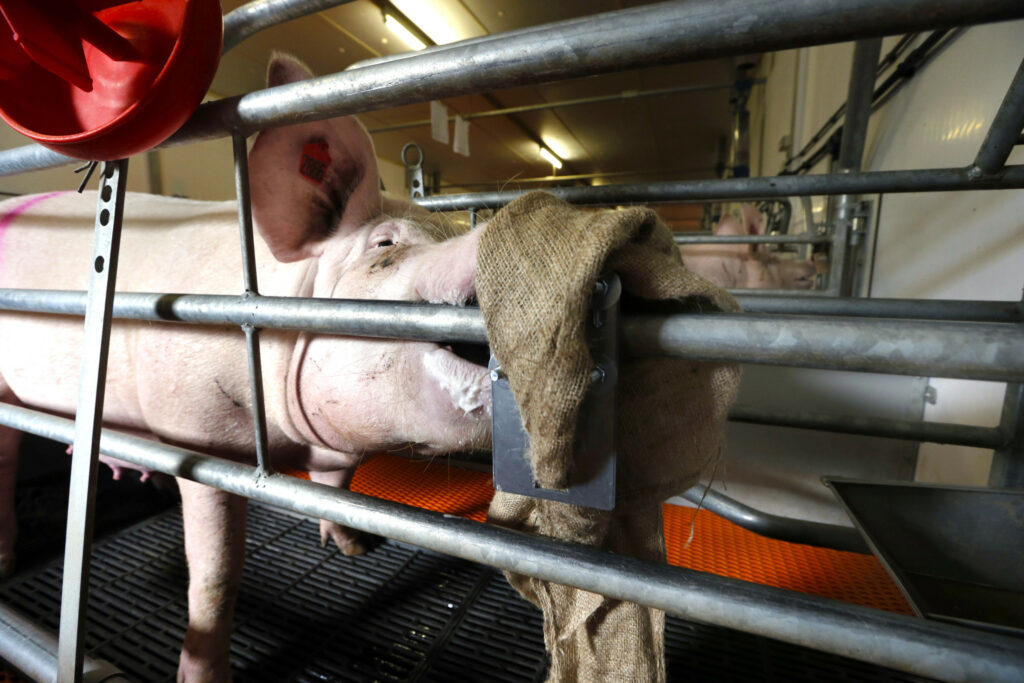
Conclusion
The design and management of the farrowing environment will impact the working conditions for stock people and the productivity and welfare of the sow and her piglets. Basic requirements for sows, piglets and the workforce, must comply with local legislation and accommodate the dimensions of the animals and the space required for the performance of those activities that will most likely lead to improved animal welfare and productivity. Providing the animals with choices like availability of nest building material, sufficient quantities of feed and water, as well as adjusting the complexity in the rearing environment, supports both improved productivity and welfare.
The considerations mentioned here are important when farrowing and lactating sows and their piglets are housed in traditional crates. However, in future housing systems, where sows are likely to be loose housed, meeting sow and piglets needs becomes of even greater importance.
Co-author: Y.M. Seddon, University of Saskatchewan, Canada


